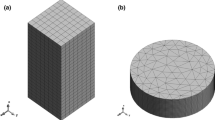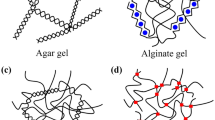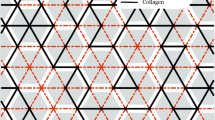Abstract
The mechanical role of non-fibrillar matrix and the nature of its interaction with the collagen network in soft tissues remain poorly understood, in part because of the lack of a simple experimental model system to quantify these interactions. This study’s objective was to examine mechanical and structural properties of collagen-agarose co-gels, utilized as a simplified model system, to understand better the relationships between the collagen network and non-fibrillar matrix. We hypothesized that the presence of agarose would have a pronounced effect on microstructural reorganization and mechanical behavior. Samples fabricated from gel solutions containing 1.0 mg/mL collagen and 0, 0.125, or 0.25% w/v agarose were evaluated via scanning electron microscopy, incremental tensile stress-relaxation tests, and polarized light imaging. While the incorporation of agarose did not dramatically alter collagen network morphology, agarose led to concentration-dependent changes in mechanical and structural properties. Specifically, resistance of co-gels to volume change corresponded with differences in fiber reorientation and elastic/viscoelastic mechanics. Results demonstrate strong relationships between tissue properties and offer insight into behavior of tissues of varying Poisson’s ratio and fiber kinematics. Results also suggest that non-fibrillar material may have significant effects on properties of artificial and native tissues even in tension, which is generally assumed to be collagen dominated.










Similar content being viewed by others
References
Batorsky, A., et al. Encapsulation of adult human mesenchymal stem cells within collagen-agarose microenvironments. Biotechnol. Bioeng. 92(4):492–500, 2005.
Billiar, K. L., and M. S. Sacks. A method to quantify the fiber kinematics of planar tissues under biaxial stretch. J. Biomech. 30(7):753–756, 1997.
Buckwalter, J. A. Musculoskeletal soft tissues. In: Orthopaedic Surgery: The Essentials, edited by M. Baratz, A. D. Watson, and J. E. Imbriglia. New York, NY: Thieme, 1999.
Chandran, P. L., and V. H. Barocas. Microstructural mechanics of collagen gels in confined compression: poroelasticity, viscoelasticity, and collapse. J. Biomech. Eng. 126(2):152–166, 2004.
Chandran, P. L., and V. H. Barocas. Affine versus non-affine fibril kinematics in collagen networks: theoretical studies of network behavior. J. Biomech. Eng. 128(2):259–270, 2006.
Cheng, V. W. T., and H. R. C. Screen. The micro-structural strain response of tendon. J. Mater. Sci. 42(21):8957–8965, 2007.
Elliott, D. M., and L. A. Setton. A linear material model for fiber-induced anisotropy of the anulus fibrosus. J. Biomech. Eng. 122(2):173–179, 2000.
Gilbert, T. W., et al. Fiber kinematics of small intestinal submucosa under biaxial and uniaxial stretch. J. Biomech. Eng. 128(6):890–898, 2006.
Guerin, H. A., and D. M. Elliott. The role of fiber-matrix interactions in a nonlinear fiber-reinforced strain energy model of tendon. J. Biomech. Eng. 127(2):345–350, 2005.
Guerin, H. A., and D. M. Elliott. Degeneration affects the fiber reorientation of human annulus fibrosus under tensile load. J. Biomech. 39(8):1410–1418, 2006.
Hewitt, J., et al. Regional material properties of the human hip joint capsule ligaments. J. Orthop. Res. 19(3):359–364, 2001.
Jones, C. P. Living beyond our “means”: new methods for comparing distributions. Am. J. Epidemiol. 146(12):1056–1066, 1997.
Knapp, D., et al. Rheology of reconstituted type I collagen gel in confined compression. J. Rheol. 41:971, 1997.
Krishnan, L., et al. Design and application of a test system for viscoelastic characterization of collagen gels. Tissue Eng. 10(1–2):241–252, 2004.
Lake, S. P. Anisotropic, Inhomogeneous and Nonlinear Structure-Function of Human Supraspinatus Tendon. Department of Bioengineering, University of Pennsylvania, Philadelphia, PA, 2009.
Lake, S. P. et al. Evaluation of affine fiber kinematics in human supraspinatus tendon using quantitative projection plot analysis. Biomech. Model Mechanobiol. 2011 (in press).
Lanir, Y. A structural theory for the homogeneous biaxial stress-strain relationships in flat collagenous tissues. J. Biomech. 12(6):423–436, 1979.
Laurencin, C. T., et al. Tissue engineering: orthopedic applications. Annu. Rev. Biomed. Eng. 1:19–46, 1999.
Lund, A. W., et al. Osteogenic differentiation of mesenchymal stem cells in defined protein beads. J. Biomed. Mater. Res. B 87(1):213–221, 2008.
Lynch, H. A., et al. Effect of fiber orientation and strain rate on the nonlinear uniaxial tensile material properties of tendon. J. Biomech. Eng. 125(5):726–731, 2003.
Malvern, L. E. Introduction to the Mechanics of a Continuous Medium. Englewood Cliffs, NJ: Prentice-Hall, 1969.
Nomura, Y., Y. Ishii, and K. Takahashi. Control of collagen molecular assembly with anionic polysaccharides. Biosci. Biotechnol. Biochem. 73(4):926–929, 2009.
Normand, V., et al. New insight into agarose gel mechanical properties. Biomacromolecules 1(4):730–738, 2001.
O’Connell, G. D., H. L. Guerin, and D. M. Elliott. Theoretical and uniaxial experimental evaluation of human annulus fibrosus degeneration. J. Biomech. Eng. 131(11):111007, 2009.
Reese, S. P., S. A. Maas, and J. A. Weiss. Micromechanical models of helical superstructures in ligament and tendon fibers predict large poisson’s ratios. J. Biomech. 43(7):1394–1400, 2010.
Roeder, B. A., et al. Tensile mechanical properties of three-dimensional type I collagen extracellular matrices with varied microstructure. J. Biomech. Eng. 124(2):214–222, 2002.
Schwartz, M. H., P. H. Leo, and J. L. Lewis. A microstructural model for the elastic response of articular cartilage. J. Biomech. 27(7):865–873, 1994.
Shirazi, R., and A. Shirazi-Adl. Deep vertical collagen fibrils play a significant role in mechanics of articular cartilage. J. Orthop. Res. 26(5):608–615, 2008.
Stylianopoulos, T., and V. H. Barocas. Multiscale, structure-based modeling for the elastic mechanical behavior of arterial walls. J. Biomech. Eng. 129(4):611–618, 2007.
Stylianopoulos, T., and V. H. Barocas. Volume-averaging theory for the study of the mechanics of collagen networks. Comput. Methods Biomech. Biomed. Eng. 196(31–32):2981–2990, 2007.
Thomopoulos, S., G. M. Fomovsky, and J. W. Holmes. The development of structural and mechanical anisotropy in fibroblast populated collagen gels. J. Biomech. Eng. 127(5):742–750, 2005.
Tower, T. T., M. R. Neidert, and R. T. Tranquillo. Fiber alignment imaging during mechanical testing of soft tissues. Ann. Biomed. Eng. 30(10):1221–1233, 2002.
Ulrich, T. A., et al. Probing cellular mechanobiology in three-dimensional culture with collagen-agarose matrices. Biomaterials 31(7):1875–1884, 2010.
Wagner, D. R., and J. C. Lotz. Theoretical model and experimental results for the nonlinear elastic behavior of human annulus fibrosus. J. Orthop. Res. 22(4):901–909, 2004.
Wang, J. H. Mechanobiology of tendon. J. Biomech. 39(9):1563–1582, 2006.
Weiss, J. A., B. N. Maker, and S. Govindjee. Finite element implementation of incompressible, transversely isotropic hyperelasticity. Comput. Methods Biomech. Biomed. Eng. 135:107–128, 1996.
Wood, G. C., and M. K. Keech. The formation of fibrils from collagen solutions. 1. The effect of experimental conditions: kinetic and electron-microscope studies. Biochem. J. 75:588–598, 1960.
Yeh, G., and J. L. Esterhai. Orthopaedics. In: The Surgical Review: An Integrated Basic and Clinical Science Guide, edited by D. Kreisal, A. S. Krupnick, and L. R. Kaiser. Philadelphia, PA: Lippincott Williams and Wilkins, 2000.
Acknowledgments
The authors thank Victor Lai, Xiao Zhong, and Sadie Doggett for help with SEM acquisition, mechanical testing, and data analysis, respectively. We gratefully acknowledge the financial support of NIH Grants R01-EB005813 and F32-EB012352, and the NSF’s support of the University of Minnesota’s Characterization Facility.
Conflict of Interest
No benefits in any form have been or will be received from a commercial party related directly or indirectly to the subject of this manuscript.
Author information
Authors and Affiliations
Corresponding author
Additional information
Associate Editor Michael S. Detamore oversaw the review of this article.
Rights and permissions
About this article
Cite this article
Lake, S.P., Barocas, V.H. Mechanical and Structural Contribution of Non-Fibrillar Matrix in Uniaxial Tension: A Collagen-Agarose Co-Gel Model. Ann Biomed Eng 39, 1891–1903 (2011). https://doi.org/10.1007/s10439-011-0298-1
Received:
Accepted:
Published:
Issue Date:
DOI: https://doi.org/10.1007/s10439-011-0298-1




